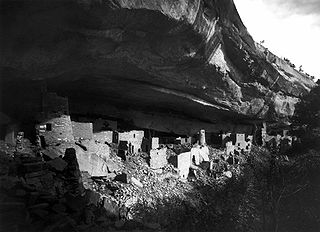
Montezuma County is the southwesternmost of the 64 counties in the U.S. state of Colorado. As of the 2010 census, the population was 25,535. The county seat is Cortez.

Cortez is a Home Rule Municipality that is the county seat and the most populous municipality of Montezuma County, Colorado, United States. The city population was 8,482 at the 2010 United States Census.

Mesa Verde National Park is an American national park and UNESCO World Heritage Site located in Montezuma County, Colorado. The park protects some of the best-preserved Ancestral Puebloan archaeological sites in the United States.

Cliff Palace is the largest cliff dwelling in North America. The structure built by the Ancestral Puebloans is located in Mesa Verde National Park in their former homeland region. The cliff dwelling and park are in the southwestern corner of Colorado, in the Southwestern United States.

Hovenweep National Monument is located on land in southwestern Colorado and southeastern Utah, between Cortez, Colorado and Blanding, Utah on the Cajon Mesa of the Great Sage Plain. Shallow tributaries run through the wide and deep canyons into the San Juan River.

Yucca House National Monument is a United States National Monument located in Montezuma County, Colorado between the towns of Towaoc and Cortez, Colorado. Yucca House is a large, unexcavated Ancestral Puebloan archaeological site.

The Manitou Cliff Dwellings are a group of relocated Ancestral Puebloan cliff dwellings and museums located just west of Colorado Springs, Colorado, on U.S. Highway 24 in Manitou Springs.

Gustaf Nordenskiöld was a Swedish scholar of Finnish-Swedish descent who was the first to scientifically study the ancient Pueblo ruins in Mesa Verde. He was a member of the Nordenskiöld family of scientists and the eldest son of polar explorer Baron Adolf Erik Nordenskiöld and his equally aristocratic wife, Anna Maria Mannerheim.
Hawkins Preserve is a 122-acre (0.49 km2) property within the city limits of Cortez, Colorado. It is protected by a conservation easement held by the Montezuma Land Conservancy.
Richard Wetherill (1858–1910), a member of a prominent Colorado ranching family, was an amateur explorer in the discovery, research and excavation of sites associated with the Ancient Pueblo People. He is credited with the discovery of Cliff Palace in Mesa Verde and was responsible for initially selecting the term Anasazi, Navajo for ancient enemies, as the name for these ancient people. He also discovered Kiet Seel ruin, now included, along with Betatakin ruin, in Navajo National Monument in northeastern Arizona. "Slightly smaller than Cliff Palace, Kiet Seel possesses qualities that, in the eyes of some, lend it greater charm and interest." Wetherill became fascinated by the ruins and artifacts and made a career as an explorer, guide, excavator and trading post operator.
Frederick Hastings Chapin was an American businessman, mountaineer, photographer, amateur archaeologist and author. He is best known for his exploration of mesas and ancient Pueblo ruins found in the Mesa Verde area of Colorado.

Alice Eastwood was a Canadian American botanist. She is credited with building the botanical collection at the California Academy of Sciences, in San Francisco. She published over 310 scientific articles and authored 395 land plant species names, the fourth-highest number of such names authored by any female scientist. There are seventeen currently recognized species named for her, as well as the genera Eastwoodia and Aliciella.
McClurg is a surname. Notable people with the surname include:

Hundreds of Ancestral Puebloan dwellings are found across the American Southwest. With almost all constructed well before 1492 CE, these Puebloan towns and villages are located throughout the geography of the Southwest.

The Ansel Hall Ruin, also known as Cahone Ruin, is located in Cahone, Dolores County, Colorado. A pre-historic ruins from the Pueblo II period, the Northern San Juan pueblo was added to the National Register of Historic Places in 1997.

The Pueblo III Period was the third period, also called the "Great Pueblo period" when Ancestral Puebloans lived in large cliff-dwelling, multi-storied pueblo, or cliff-side talus house communities. By the end of the period, the ancient people of the Four Corners region migrated south into larger, centralized pueblos in central and southern Arizona and New Mexico.

The Mesa Verde Region is a portion of the Colorado Plateau in the United States that extends through parts of New Mexico, Colorado and Utah. It is bounded by the San Juan River to the south, the Piedra River to the east, the San Juan Mountains to the north and the Colorado River to the west.

The Ancestral Puebloans were an ancient Native American culture that spanned the present-day Four Corners region of the United States, comprising southeastern Utah, northeastern Arizona, northwestern New Mexico, and southwestern Colorado. The Ancestral Puebloans are believed to have developed, at least in part, from the Oshara Tradition, who developed from the Picosa culture.
Lucy Evelyn Peabody was an American activist. She is known as the "Mother of Mesa Verde National Park," for her role in establishing the Colorado ruins as a National Park alongside Virginia McClurg. She was also involved in state politics in Colorado and was a member of a number of archeological and political associations.

















